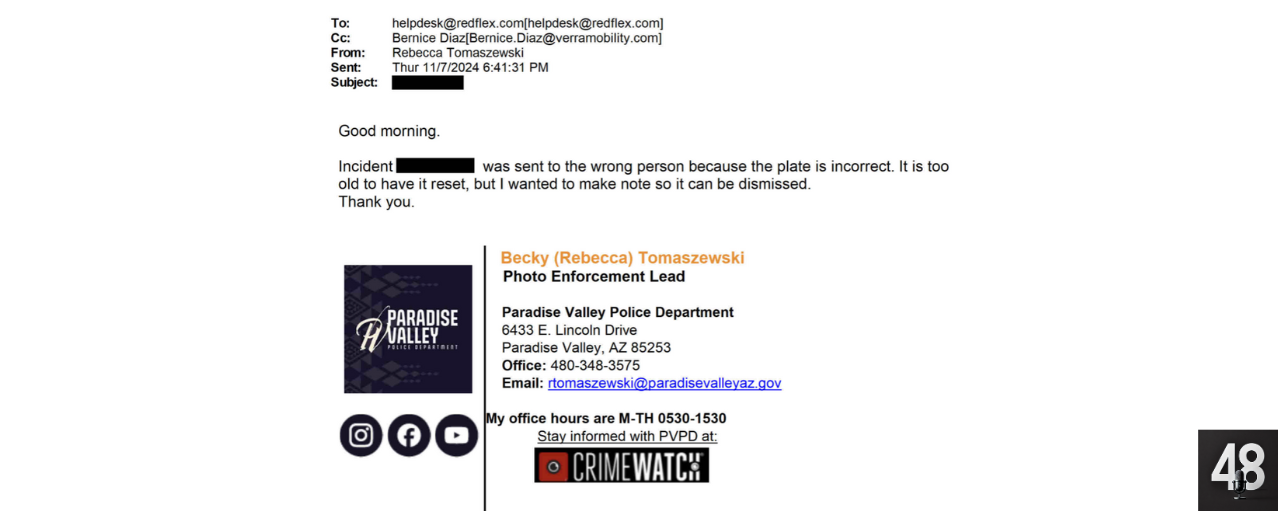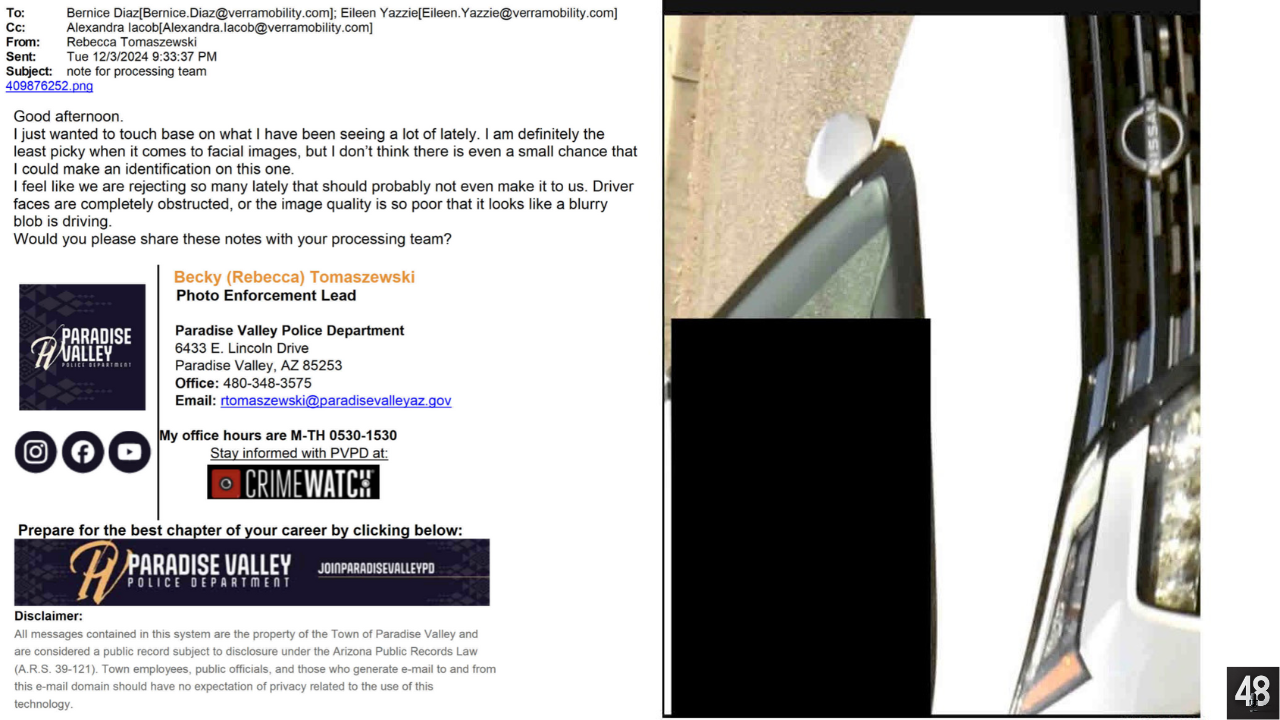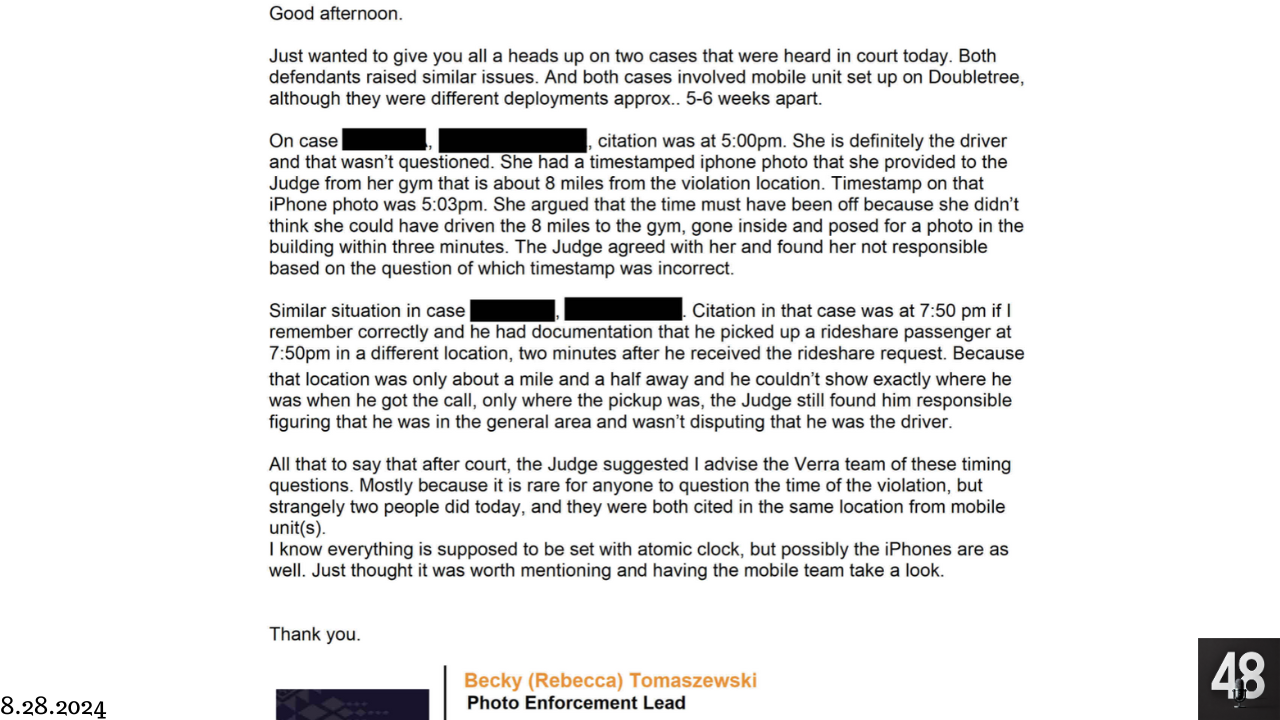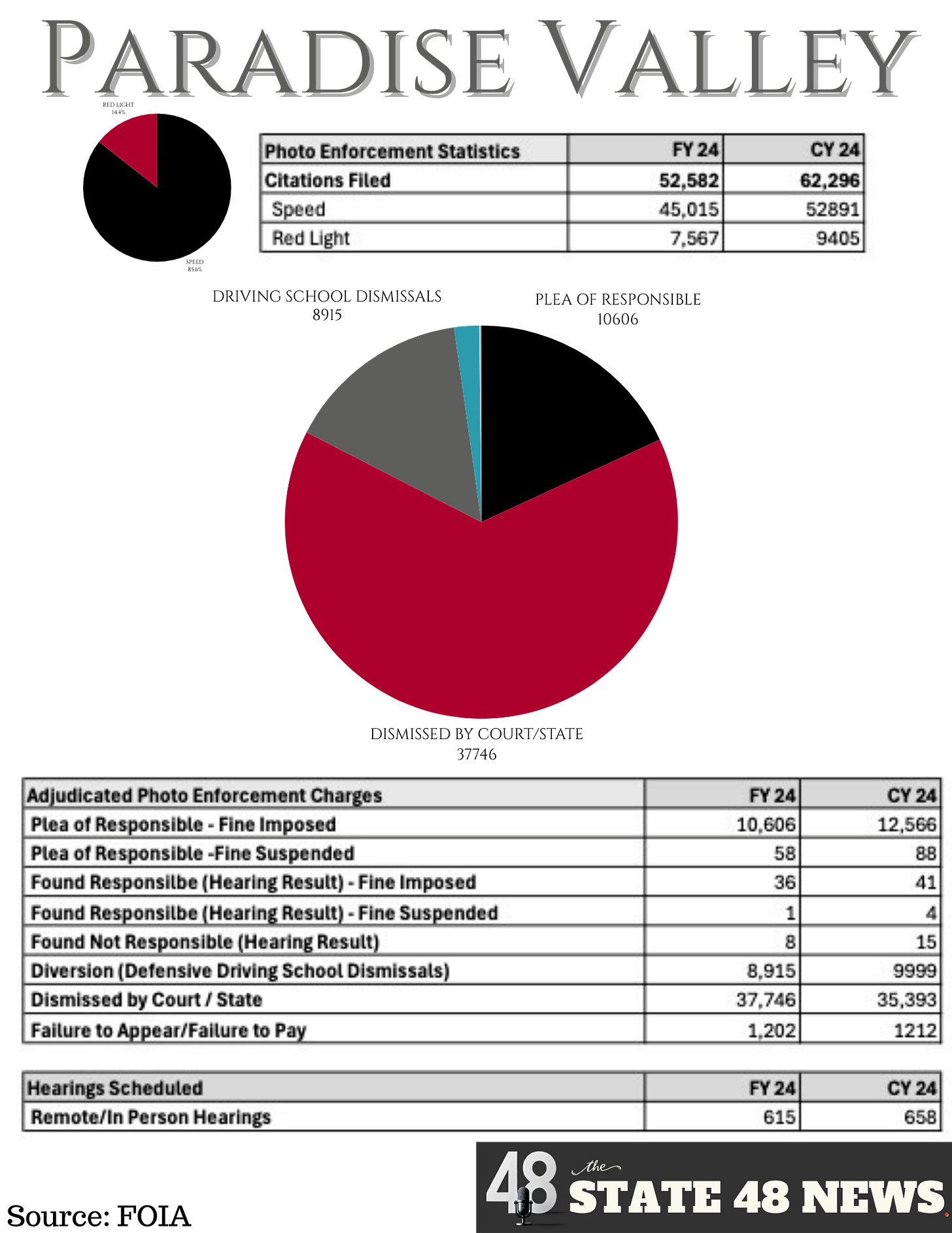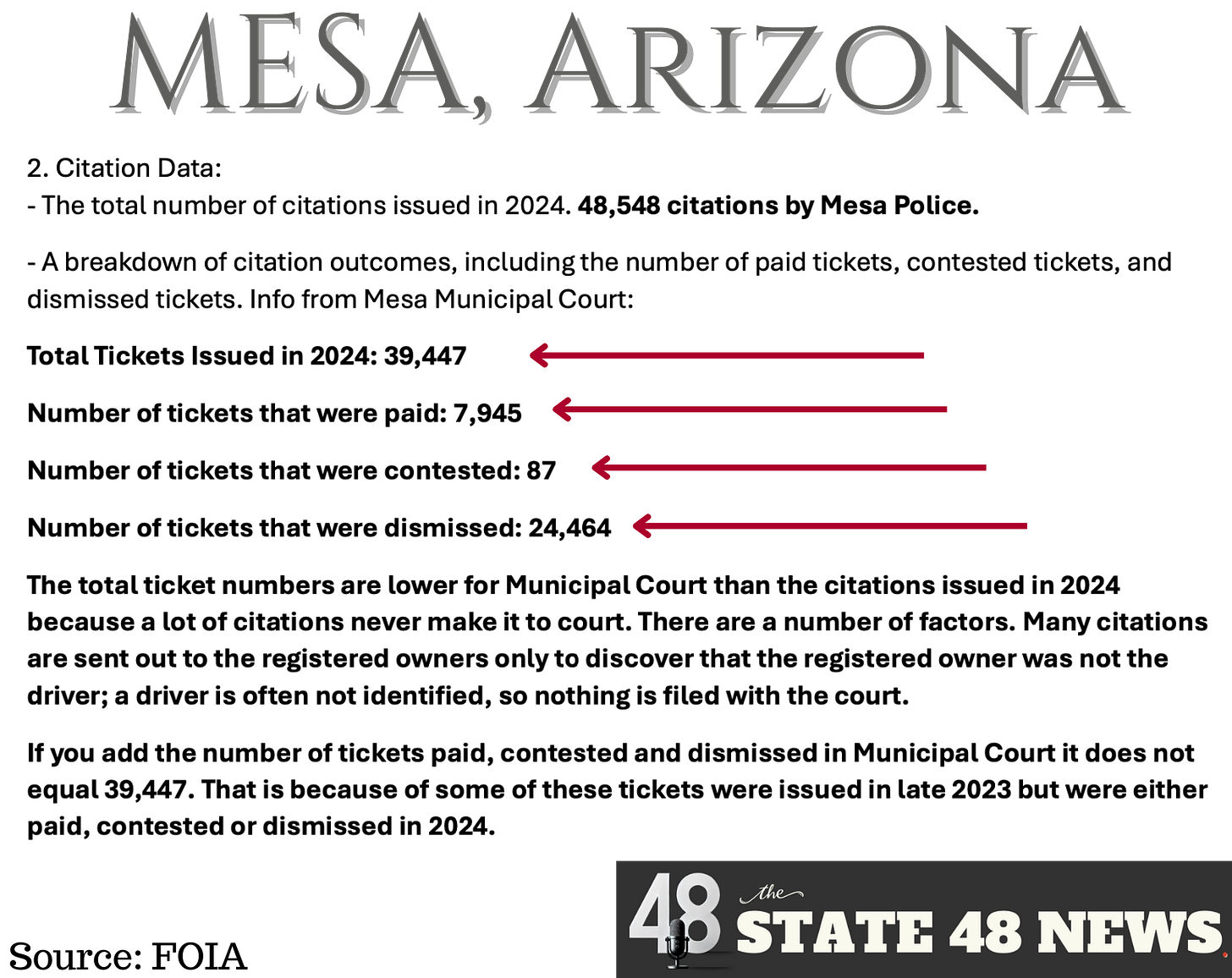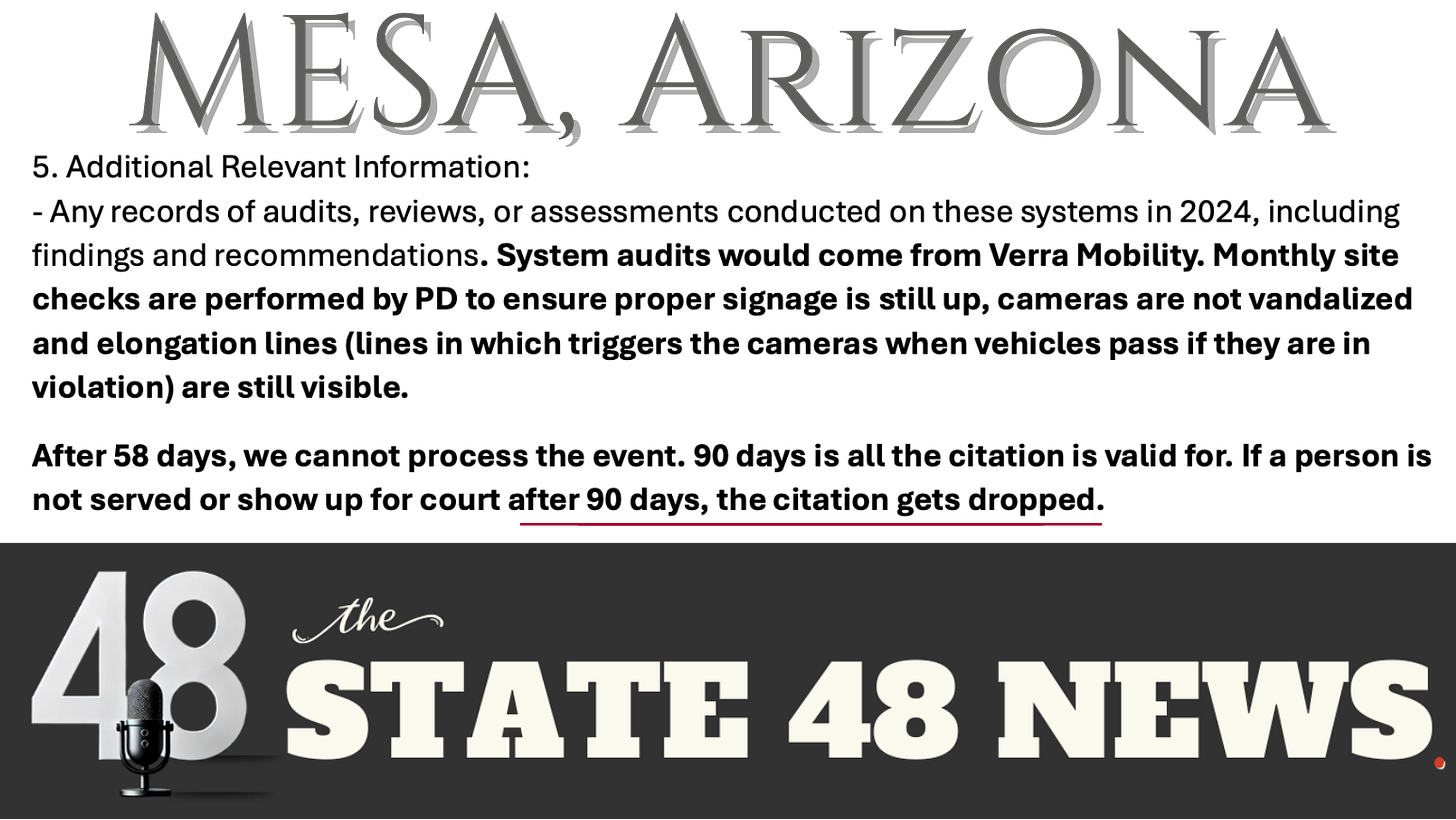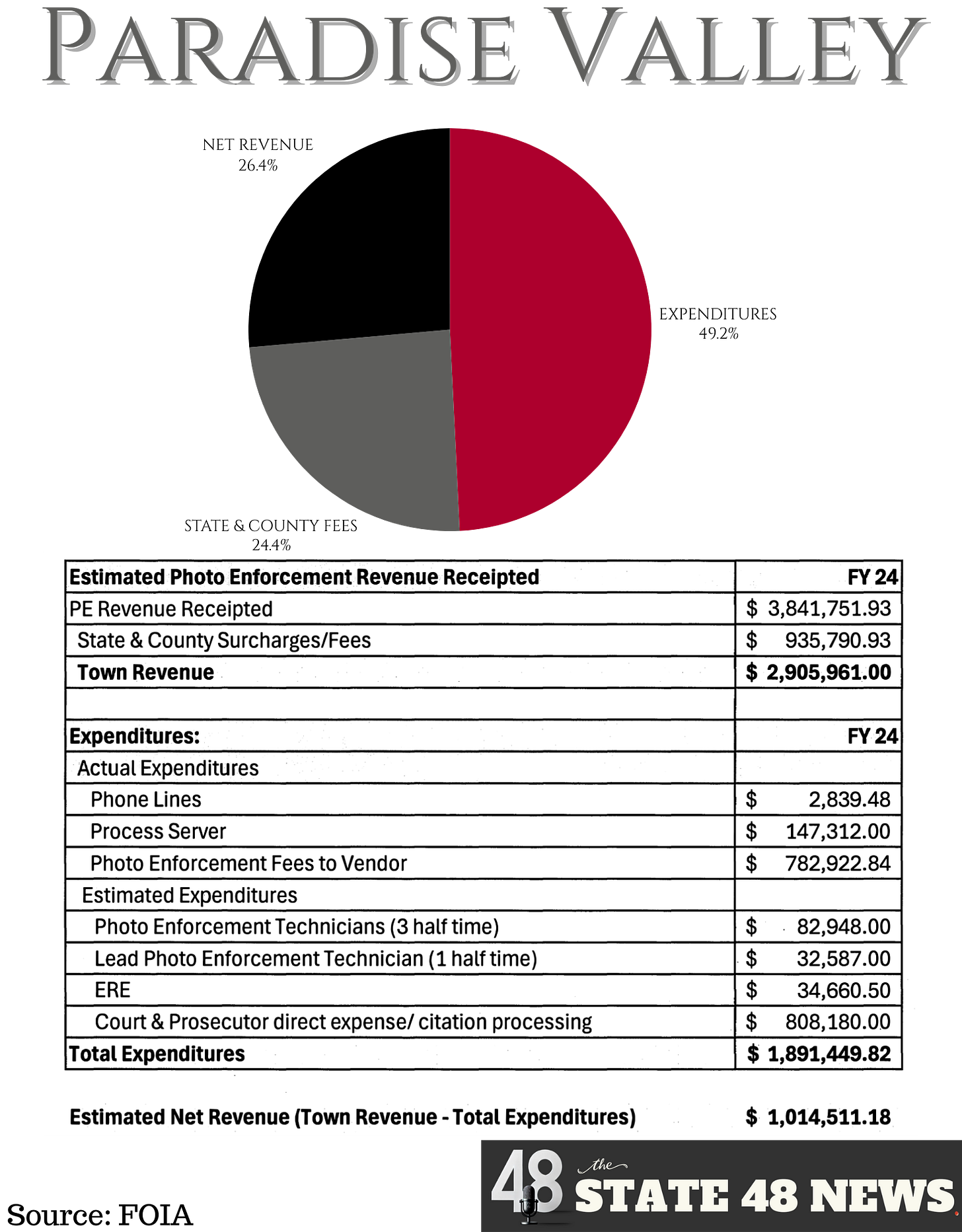Red Lights, Radar, and Revenue: State 48 News Finds Roughly 70% of Photo Radar Tickets Tossed
Thousands of Arizona drivers are beating photo radar tickets—while cities rake in millions despite errors, delays, and dismissed cases.
State 48 News has extended an invitation to both Paradise Valley and Mesa, Arizona to officially comment on this story.
Editor’s Note: Paradise Valley officials have not responded to our invites for comment, and the Mesa Police Department has declined to comment. We remain committed to transparency and public understanding, and both entities are welcome to join our podcast at any time to discuss these programs in greater detail.
Faced with growing traffic concerns and shrinking police resources, many Arizona towns and cities turn to photo radar as a modern solution—one that promises to slow drivers, reduce crashes, and ease the burden on understaffed departments. For some, it’s also become a source of steady revenue, quietly built into municipal budgets.
But behind the flashing cameras and automated citations lies a far more complex reality.
In this next report of a State 48 News investigation, we examine the raw data and internal records revealing how photo radar is used across Arizona—and why the question of whether it should continue may soon be in the hands of voters.
⚖️ With photo radar emerging as one of the most debated issues this legislative session, Arizona lawmakers have heard passionate testimony from both sides. Police departments and city officials from Phoenix, Mesa, and Paradise Valley have voiced strong support, citing safety and staffing benefits. But critics have shown up, too—raising concerns about accuracy, fairness, and privacy.
To provide historical context and help analyze the FOIA records obtained by State 48 News, we turned to Shawn Dow, a longtime photo radar critic and expert with Campaign for Liberty.
Verra Mobility, the Mesa-based company behind many of Arizona’s photo enforcement systems, bills itself as a global leader in “smart transportation.”
State 48 News obtained records confirming both the Town of Paradise Valley and the City of Mesa have active contracts with the company—with Mesa paying $1.65 million annually and Paradise Valley taxpayers contributing $782,922.84 in Fiscal Year 2024. Internal emails also show both Verra Mobility and its subsidiary Redflex playing key roles in Paradise Valley’s automated ticketing operations.
“As America’s—and Arizona’s—number-one provider of photo enforcement programs, we understand the services sought through this RFP, and we believe we have the red-light and speed safety camera solution that will help the Town continue to improve community safety on public streets, along expansion into school and residential zones. In addition, we have the qualifications and the experience that will help you rest assured that your program will be implemented and supported by a trusted and knowledgeable company.”
“Verra Mobility’s experience in Arizona means that we know what it takes to implement a program in the State, including having the appropriate private investigator licenses in place and authority to do business in Arizona. Verra Mobility is qualified to continue to furnish, install and administer a comprehensive Automated Photo Enforcement System that includes industry-leading technologies for vehicle monitoring, violation detection and complete evidence sets of potential violations.”
Verra Mobility | RFP | July 26, 2021
While Paradise Valley Mayor Mark Stanton testified in February the town issued 100,000 tickets last year, records tell a different story: the actual number in the 2024 calendar year was 62,296. And of those, only a fraction of drivers paid the fines.
“How did they go down by 50,000 in one month from what they testified in the hearing?” asks Shawn Dow, a photo radar expert with Campaign for Liberty.
We asked Dow if it’s true that simply avoiding a photo radar ticket can get it dismissed. His response: “It is absolutely true. There are not enough process servers in the whole world to serve 200,000 tickets per city per year.” Representatives Contreras (D) and Martinez (R) also confirmed this during a recent Arizona House hearing.
*Note: Dow makes it clear—once a process server hands you a citation, you’re legally required to respond. Ignoring it at that point is no longer an option.
FROM FLASH TO FINE
Photo radar relies on radar sensors and cameras to detect speeding, capturing images of both the vehicle and the driver—but the system’s effectiveness is in question as most citations never lead to payment or court action.
In our March 19th report, we recapped how Arizona lawmakers put Verra Mobility’s top lobbyist in the hot seat, pressing him on license plate tracking, privacy, and why photo radar reforms seen in other states haven’t happened here. When asked if cameras scan every plate, Jay Kaprosy dodged, saying images are only kept if a violation occurs—without confirming whether every car is scanned. Records show otherwise and State 48 News will have more on this finding in a future report.
Automation Isn’t Always Accurate
Internal emails obtained by State 48 News reveal mishaps over the accuracy of cities’ photo radar systems—including misread license plates, blurry images, incorrect time stamps, and citations sent to the wrong drivers—raising serious questions about the reliability and fairness of automated traffic enforcement.
Insiders sound the alarm. In one email from August 2024, a photo enforcement lead vents frustration over “a ridiculous number of photos” marred by poor quality and sun glare—so bad, she says, “you practically can’t even see a person in the driver’s seat.”
In this December 2024 email, Paradise Valley’s Photo Enforcement Lead raises concerns about the volume of unusable photo radar images making it through to review—noting that many are so poor in quality they should be rejected outright. She describes images where driver faces are either completely obstructed or so blurry “it looks like a blob is driving,” and suggests the rejection rate should be higher. Redacted records make our public inspection of the driver impossible.
From what we can tell in the emails obtained through FOIA records requests, it appears the Paradise Valley photo enforcement technicians can request Redflex/Verra Mobility to have errors corrected.
FROM FINE TO FIGHT
The big question: Is it even worth fighting a photo radar citation?
Internal emails from Paradise Valley reveal cases where a judge was asked to dismiss photo radar citations due to conflicting timestamps and questionable accuracy. One woman proved she couldn’t have been at the scene at the time, and the judge tossed her ticket. Another driver, with similar doubts about timing, wasn’t so lucky. Both cases came from a mobile unit — weeks apart — raising concerns about the system’s internal clock.
Taking a photo radar ticket to court? It’s a gamble—and the odds are stacked.
In Fiscal Year 2024, the Town of Paradise Valley issued 52,582 citations through its photo radar program. That’s an eye-popping number for a town of just 12,000 people—proof the system isn’t just active, it’s aggressive.
Speeding made up 86% of the violations. Red light tickets? Just 14%.
Most drivers don’t bother fighting. Fewer than 1 in 5 opt for defensive driving school. Roughly 20% just pay up.
🚨 But here’s the twist: More than 70% of tickets—a staggering 37,746—were dismissed.
And for the few who make it to court? It's still a roll of the dice.
Out of 615 hearings:
36 were found responsible
1 had their fine suspended
8 were found not responsible
Whether it's flawed evidence or legal loopholes, Paradise Valley’s system may write a lot of tickets—but getting them to stick is another story.
FROM FIGHT TO FORGOTTEN
The Town Clerk in Paradise Valley tells us most photo radar citations in Arizona are dismissed because they aren’t served within 90 days, as required under Rule 4(i) of the Arizona Rules of Civil Procedure. If a defendant isn’t served or doesn’t respond by paying, attending traffic school, or contesting the charge, the case is dropped without prejudice.
Other common reasons for dismissal include:
Non-driver affidavits: If the defendant proves they weren’t the driver, using a driver’s license photo that doesn’t match the enforcement image.
Multiple citations: Courts may offer plea deals when several tickets are issued in a short timeframe.
State motions to dismiss, often citing "interest of justice" or misidentification of the driver.
The story is similar in Mesa, Arizona according to FOIA records obtained by State 48 News.
In Mesa, these numbers show 62% of photo radar tickets are ultimately dismissed—a staggering figure. According to the city, many citations never even make it to court. Common issues include misidentifying the driver, failing to serve the citation within the legal window, and delays in processing.
If a driver isn’t served within 90 days—or doesn’t show up—the case is dropped. And after 58 days, the city says it can no longer process the violation at all.
FUNDING AND FAIRNESS
On March 14th, State 48 News broke news of where your dollars go when you pay a photo radar citation.
Mass Dismissals, Million-Dollar Paydays
Newly obtained FOIA records reveal that despite only about 20% of cited drivers paying their photo radar tickets, the Town of Paradise Valley still receipted $3.8 million in Fiscal Year 2024. Less than $1 million was passed along to the state and county in required surcharges and fees. That left the town with $2.9 million in revenue—and after covering expenses, a net profit of over $1 million ($1,014,511.18).
The numbers highlight just how lucrative photo enforcement remains—even when most citations never result in payment.
In Paradise Valley, Arizona, 79% of every speeding ticket fine goes to the state of Arizona. Dollars are allocated to state-mandated surcharges, funding programs such as law enforcement training, public safety, forensic investigations, medical services, victim support, and Arizona's Clean Elections Fund.
Clean Elections Controversy? As State 48 News has reported, fines from photo radar violations help fund Arizona’s Clean Elections system, which provides public financing for political campaigns.
Yep, you read that right—politicians can cash in on the fines you pay for speeding. And in the Arizona Legislature, lawmakers will be deciding whether to let cities keep control of photo radar or hand the decision to the voters.
➡️ Coming soon: State 48 News will reveal how long Arizona cities are storing your license plate location data, why some police departments exceed the 30-day limit, how much it costs taxpayers, and how that data is shared.
We’ll also dig into complaints about constant photo radar flashes—and show how photo radar vendors depend on police departments to access private citizens’ DMV records, leading to delays and technical problems.
THE MORE YOU KNOW.
“I hope it’s not dead,” those are the words from Senate President Warren Petersen.
State 48 News has learned Senate Concurrent Resolutions (SCRs) are being held for the final stretch of the legislative session. What does that mean for SCR1002?
This resolution, which is currently in the Arizona House of Representatitves, would ban the use of photo enforcement systems for traffic law violations—pending voter approval. The resolution would bypass Governor Hobbs’ veto pen.
Senate President Warren Petersen tells State 48 News ballot referrals like SCR1002 will be addressed at the end of session, around the same time the state budget is finalized. Sen. Rogers has not responded to our requests for comment.
🚨 SCR1002—designed to place a statewide ban or expansion of photo enforcement on the 2026 ballot—was double-assigned by House Speaker Steve Montenegro, including to the House Government Committee chaired by Rep. Walt Blackman (R-LD7), who has a tense history with bill sponsor Sen. Wendy Rogers.
Blackman initially placed the resolution on his agenda—then abruptly pulled it. No other committee has picked it up. In an exclusive interview, Blackman told State 48 News why.
Back in 2019, Blackman co-sponsored a bill to ban photo radar alongside Sens. Kevin Payne and Frank Carroll—both of whom now appear to have reversed their positions.
Meanwhile, fresh concerns emerged when Rep. Pamela Carter (R) voted “present” on photo radar, saying she needed to consult unnamed advisors. Sources say a proposed amendment could create a “carve-out” for Paradise Valley, allowing the town to keep its cameras despite a statewide ban—preserving local control.
State 48 News will continue to follow this developing story.





